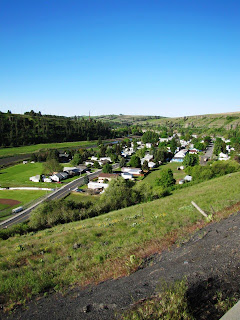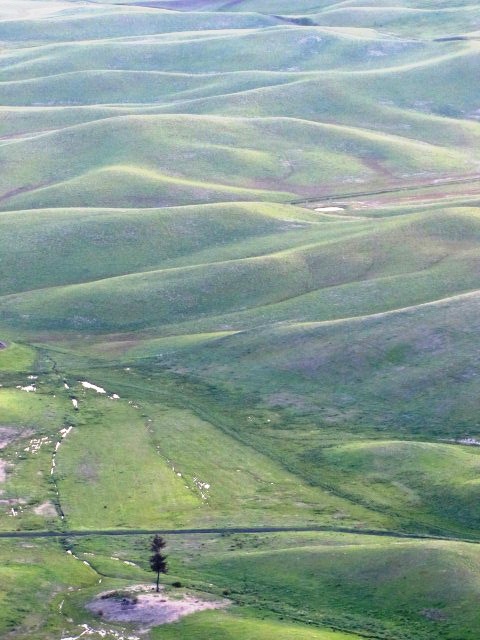 |
| Dry Falls - Grant County |
I've been watching more and more birds come back to the neighborhood, the county, and the state in the last few weeks, but May has always been a time when more time and energy needs to go to coaching track, as we move towards the end of the season and the state track meet in Cheney; I hadn't really gotten out much, but the Memorial Day weekend was bringing us to Cheney once more. We were only able to get one athlete through to state this time (next year!... next year...), and this was my last year head coaching, so I made this a birding trip, joining my distance coach and distance runner for all of the meet in between.
 |
| Wanapum Dam on the Columbia River |
Thursday began with a trip across I-90 to Wanapum Dam State Park. There has been a family of Long-eared Owls seen pretty reliably there for the last few months, and this is a bird I've never seen. Many people had seen them in the same tree for the first months of the year, but with the owlets getting bigger, they had started to move around a little.
I checked a tree where they had been seen recently and found my first owl pellet! Owls eat their prey whole - bones, hair and all - then hack up the mother of all hair balls, the owl pellet. I checked the tree for owls - no dice. I kept walking the campground, and saw several first-of-year (FOY) birds, including a Cassin's Vireo and Bullock's Oriole. Finally, I found a tree with something in it. It was not good news, and I'm still waiting for someone to help me make sense of the picture I took, but I think I found a dead owl (adult? fledgeling?) in a tree branch. An owlet had fallen out of the tree during a storm last week, before it could fly; It was taken to rehabilitation. I don't know if this was adult or fledgeling, or what would have caused this, but it was very sad to see (and not the last dead owl I would see on the trip, even more sadly.). I saw no other owls, which may speak more to my inexperience with finding day roosting owls than anything else.
 |
| Common Loon pair |
Moving to the boat launch, I found the Columbia was fairly empty, although there was this beautiful pair of Common Loons, and another FOY bird - Bank Swallows! Most of the other swallows show up in a lot of different places, but for the most part, Bank Swallows are just found at their colonies along river banks. I saw one here, and one two days later in Whitman County, so it was a good trip for those swallows. Also, without really "doing" Kittitas County, I'd passed 39 birds there just by making stops while passing through.
 |
| Oasis Park - Ephrata |
I ate the lunch I'd packed and crossed the Columbia into Grant County. I was aiming for Highway 2, which meant driving through Ephrata. The day before I left, a report had come in that a Blackpoll Warbler had been seen at Oasis Park, right on my route, so I made a stop at this nice little migrant trap. This was a good stop, with lots of warblers, including a MacGillvray's which I got to see quite well. I was looking around for a warbler with a black cap (oops... didn't know that this was a female I was looking for), and had time, so I walked the park picking over the birds.
One bird puzzled me - the wing bars and olive coloring, hint of an eye ring, and short dark bill had me thinking it was a Dusky Flycatcher... but it was not acting like a flycatcher! It was picking its way silently through the branches in the right area where the warbler had been sighted. Flycatchers will usually take a perch on a branch, making occasionally sallies out to snag insects, and returning to their perch. Dusky Flycatchers will also flick their tail in an up-down motion - something I never saw this bird do, despite several views of it... When I returned from my trip, I found a video had been posted of the Blackpoll. That was my bird! I'll have to ask next time I'm hunting down a rare bird if I'm looking for a male or female!
 |
| Sundial - Soap Lake |
From here, I went up the road to Soap Lake. "The Healing Waters of Soap Lake" are very alkaline, which some bacteria don't like. It was kind of cool to dip my hand in and see that it did feel soapy! The big find here was a sundial! I have brought my ninth graders to see a sundial at the University of Washington, have one in my room (an analemmic sundial, btw) and have several students checking out the "Seattle Sundial Trail" as a project for class. Running into this one was a pleasant surprise, and it was one of the more interesting ones I'd seen!
There is a winged human figure that points north, and an array of posts that are numbered IX, X, XI, XII, I, II, III. Here you can see the shadow cast - this was a little after three.
 |
| A little after 3PM at Soap Lake |
It wasn't incredibly birdy at Soap Lake - this was the first stop where I was hoping for an American Avocet, but none were here that I could see, just Killdeer and a Spotted Sandpiper working on the shore, in addition to the gulls, swallows and blackbirds around the lake.
 |
| Cliffs at Dry Falls |
Farther up the road, I made my last Grant County stop for the day - at Dry Falls State Park (better picture at top). This was once the site of the largest waterfall in the world. During the ice age, the Missoula Ice Dam would periodically break, sending huge amounts of water across Eastern Washington, and much of that down these very cliffs. As a birder, I get additional enjoyment from it, because I know I can find White-throated Swifts here. I had been there about 15 minutes, and was worried that I'd miss them, but one zipped overhead and grabbed an insect, diving back down the cliff face from there.
 |
| Yellow-headed Blackbird |
The day was moving along, and I had some stops planned in Lincoln County, so I started off again down Highway 2. Soon after crossing the county line, I saw my first Yellow-headed Blackbird of the year. This was a bird that I had only seen once in the state before - in Lincoln County when I first started birding. At the time, it was such a bizarre bird to see - with hundreds of birds I'd never identified in the state, this one was very showy, and I was scrambling through my recently purchased bird guide. I was asked later in the trip what the black birds with the yellow heads were, and I was able to tell the person without laughing, because I was asking the same thing once!

Stopped for grub in Wilbur, at Constantine's Alibi Pub and Eatery. I had a delicious Teriyaki Burger and a pint brewed at Airway Heights over in Spokane County. This gave me a chance to get my lists straightened out. I found that Grant was over 50 species now, and I also figured out which birds I had added for the year, and which I might be able to find down the road. It was also nice to stop in Wilbur, as I knew someone in college who we called Wilbur, because he was from this town. Now what was his name...!?
 |
| This could say - WARNING! Lottery tickets! |
When asking about the birding in the area, I was discouraged from going to the Swanson Lakes, south of Creston. I had plans to camp at Hawk Creek - down the road and to the north - and I knew there would be a lot of new birds for the year, and possibly some life birds on the 10-20 mile circuit, so I made the trip, and was not disappointed! I did not go in with hopes of finding any of the Sharp-tailed Grouse in this area. From all accounts, only the people managing these populations actually see them, the other birds I found made me quite happy though.
 |
| Old Schoolhouse - Swanson Lakes |
As soon as I left farmland, and entered the sage-steppe habitat that used to dominate the landscape, I pulled over to listen. This was my best sage-steppe stop of my three day trip - I picked up a Sage Thrasher, Brewer's and Grasshopper Sparrows, and a Say's Phoebe down this little side road. It was maddening to have so many unfamiliar songs going at once, but I was able to get good looks at each of them singing and perching to connect the sounds to the birds.
 |
| Black Tern... can you see it? :) |
The lakes themselves were not incredibly productive, but I did pick up Canvasback, and lots of Ruddy Ducks. Wilson's Snipes were winnowing at several stops as well. The highlight of this swing was a pullout at a little lake where I had 7 Black Terns. It was my first time seeing these lovely birds. I got a lousy picture, tried to take another, and my camera batteries gave up on me! So I spent some time just enjoying them hovering and diving, and then they gave me a treat and flew right past me to a lake across the road. This was a great lifer, and I'm hoping to see more down the road. The next day, I got a text from another birder, Randy Bjorklund, who saw his first at Nisqually NWR in Pierce County! He got a sweeeet picture of one dipping its bill in the water in his Picasa album.
Okay, so at this point, I was ready to hit Hawk Creek Campground, where I wanted to hear Poorwills at night, see a Dipper in the morning, and start finding more flycatchers and birds of the Ponderosa Pines. Sadly, the Miles-Creston Road was closed for repair, which would have added many many miles to my trip... and it was getting dark... so I spent the night in Davenport, at the Morgan Street Bed and Breakfast. During this decision, in the faint light of dusk, I passed a Great Horned Owl which flew from a telephone pole. Several more were heard from the B and B itself, where I slept verry comfortably after a long day of driving.

















































